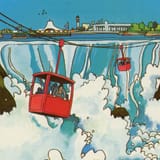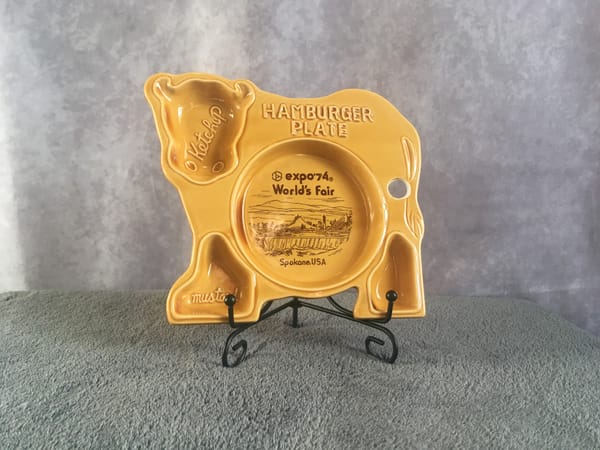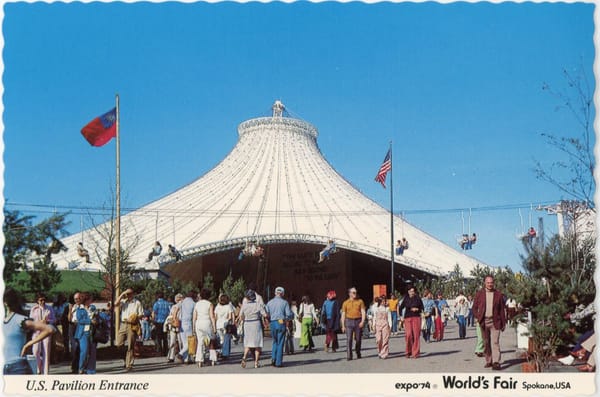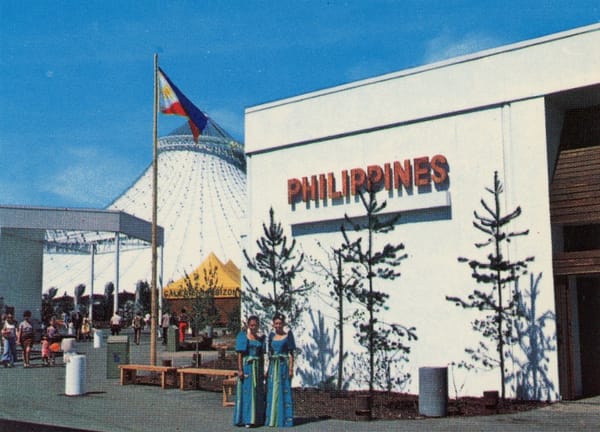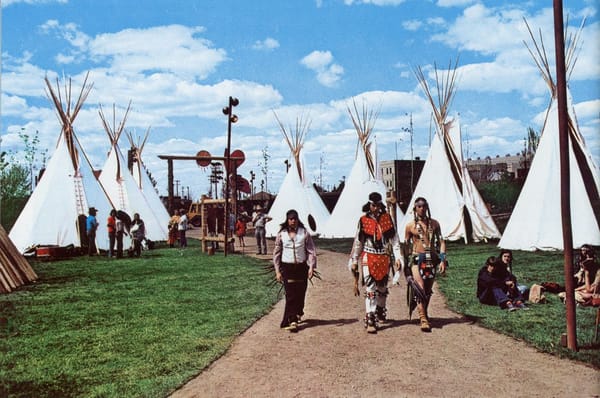June 15-June 21: Juneteenth, Books and Sloths, and Mean Mary Jean
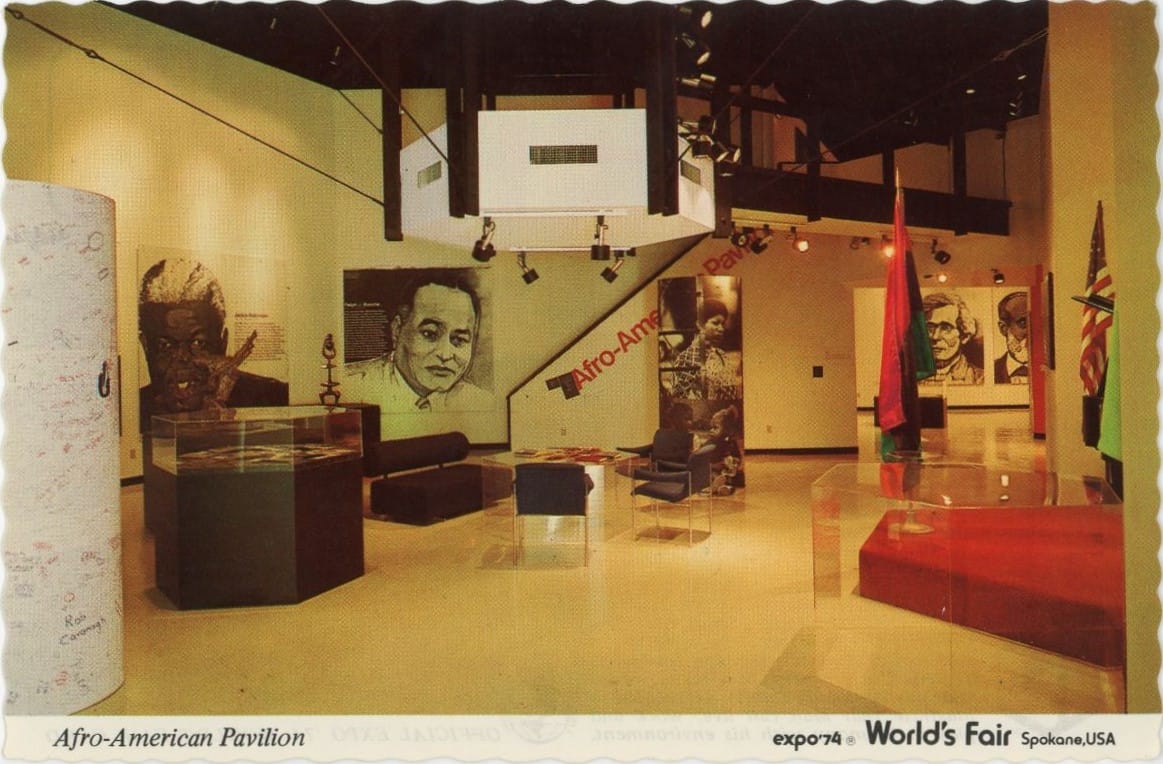
Folklife this week featured "Black Week," a celebration of African-American culture.(1) The week was scheduled to coincide with Juneteenth celebrations, and activities included music, dance, painting demonstrations, jewelry-making, quilting, and demonstrations of hair-braiding. A particularly popular artisan was Marcella Fusilier of Seattle, who demonstrated her doll-making skills.(2) The cuisine of the week was soul food, including gumbo, cornbread, and a great big barbecue cook-out.(3) I keep saying it, but only because it's so true: we should bring Folklife back.
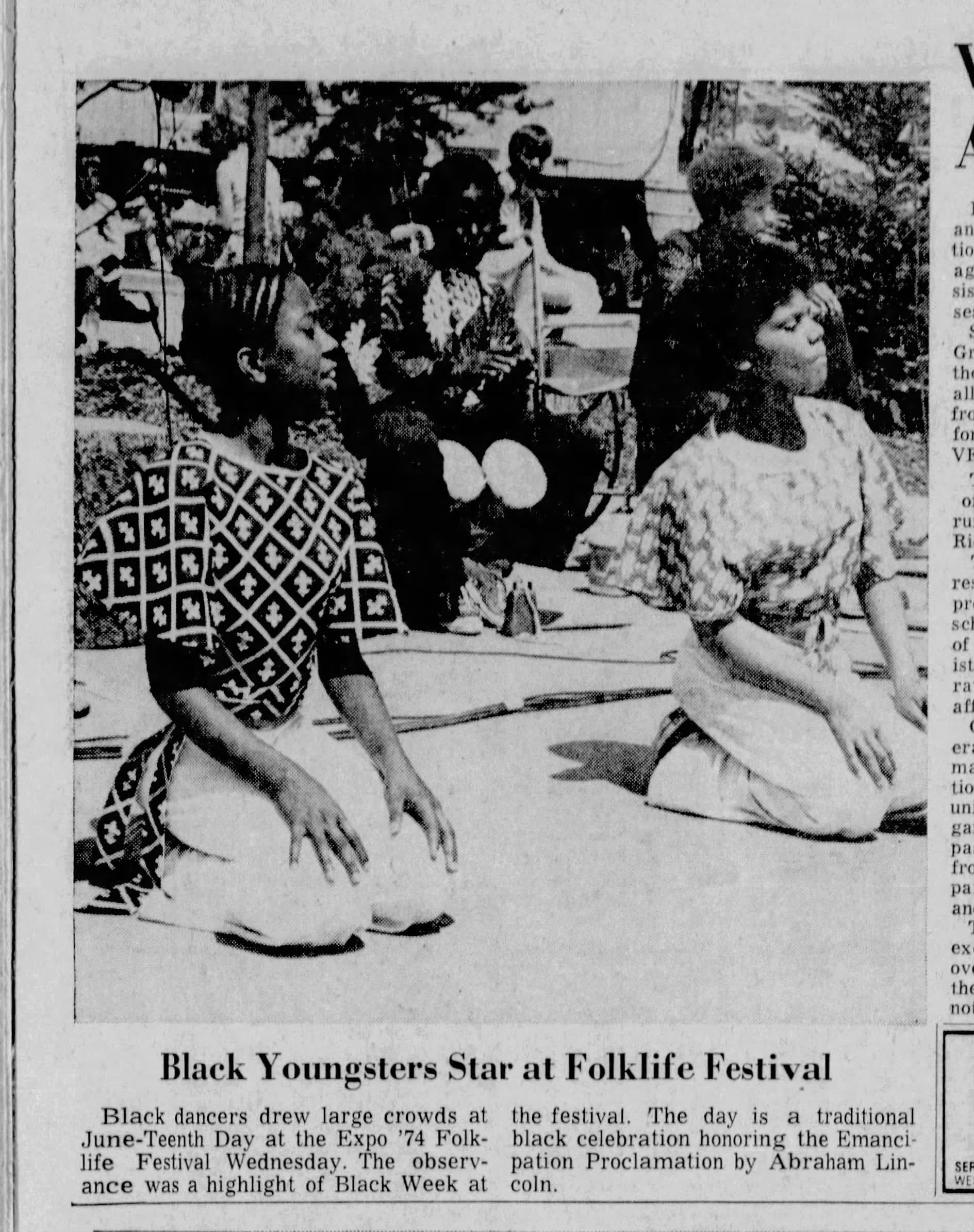
At Native Americans' Earth this week, there were special appearances by representatives from the Colville, Makah, and Arapaho nations.(4) Both the Makah and Colville groups brought delegations that were mainly composed of children and young people from their school programs.(5) The young people demonstrated traditional skills like dance, basket weaving, carving, language, and music.
This week also had the second entry in Expo '74's environmental symposium series, Population On A Small Planet. As with Energy On A Small Planet earlier, there was some concern in newspapers about the small attendance of this symposium relative to the huge crowds that were attending Expo. I think there is a valid broader critique about whether every decision for Expo '74 was made with environmentalism as its first priority, but this type of academic conference is generally about giving specialists an opportunity to gather and do their shop talk in person at a location that's worth the trip. I don't think it was ever expected to compete for participants with the pavilions.

DAILY EVENTS
Saturday, June 15th saw the kickoff of the National Wheelchair Games.(6) Most of the events were held on the campus of Eastern Washington State College (later EWU), but many of the athletes also came to visit Expo '74. The fairgrounds were designed to be fully accessible for wheelchair users, although a few areas were still off-limits, such as the escalators in the Australia pavilion. From what I have gathered, this "barrier-free design" approach was led by Expo '74 General Services manager Jim Besse with assistance from Barbara Allan, a consultant from the Easter Seal Society. (7) Besse gave an Expo tour on Friday, June 14th to Caryl Jane Robinson, Miss Wheelchair America, who was visiting for the games.(8)
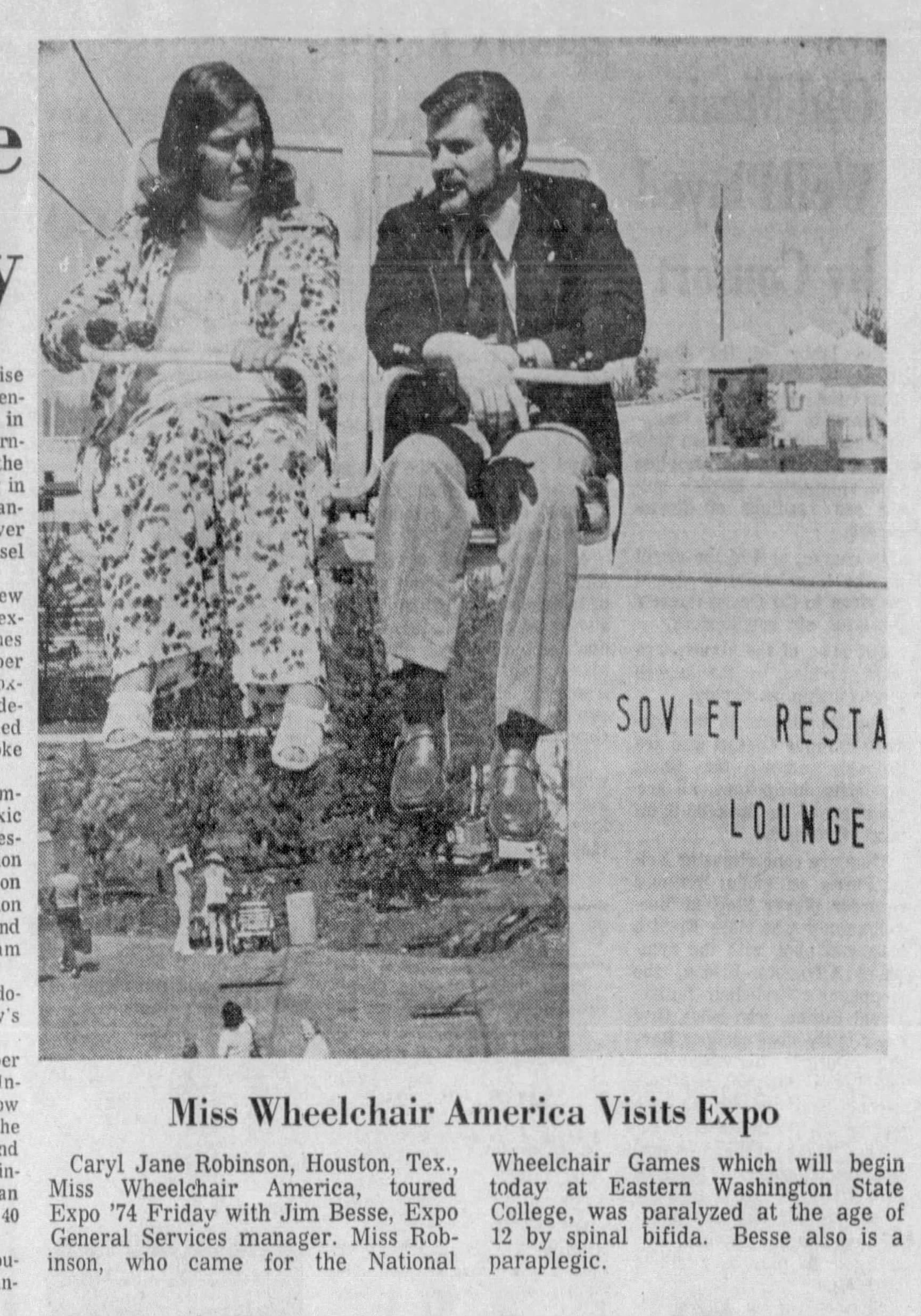
On Father's Day in the place that invented Father's Day, what else could we do but honor its inventor? Sunday, June 16th saw a celebration of Sonora Smart Dodd, the Spokane woman who had originated the holiday more than fifty years earlier.(9) Sunday was also the beginning of a handbell ringers' festival that brought hundreds of handbell ringers to Spokane; they would perform on the Expo fairgrounds throughout the day on Wednesday.(10)
Monday, June 17th witnessed the arrival of a pack of distance runners who had just completed a 300-mile relay from Monroe, Washington to Expo '74.(11) The 34 young men were raising money and awareness for the National Multiple Sclerosis Society. I'm starting to notice a pattern where running or cycling to Expo usually seems to work out well, but traveling to Expo on the water generally ends poorly.
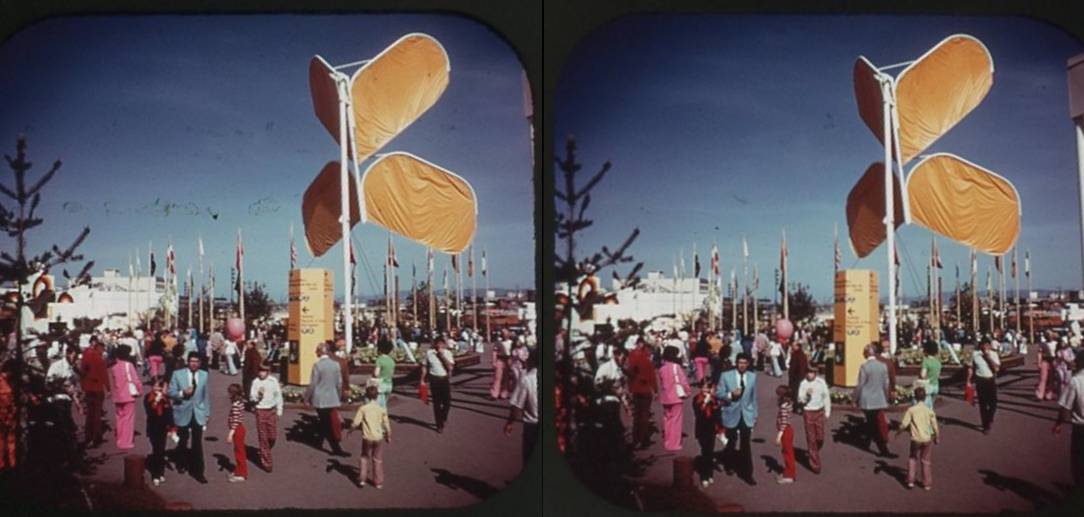
Tuesday, June 18th had the usual busy roster of school performers, dancers, mimes, clowns, and music.(12) I'm going to do that thing where I use a quieter day at Expo to highlight one of the many events that happened every day of the fair, in this case the Moody Bible Institute's Sermons from Science. The non-profit organization "Christians For Expo" conducted outreach through the Moody Bible Institute's Sermons From Science films and presentations. These shows, each around 30 minutes, reflected Dr. Irwin A. Moon's belief that "the marvels of science provided visible evidence of a divine plan of creation." For instance, "City of Bees" spends 2/3 of its runtime on straightforward scientific information about bees before addressing why humans are different from other animals and were given the Ten Commandments as a result. These presentations would run continuously over a 9-hour period each day, and are all on YouTube today. Screen-caps of their title cards are in the gallery below.
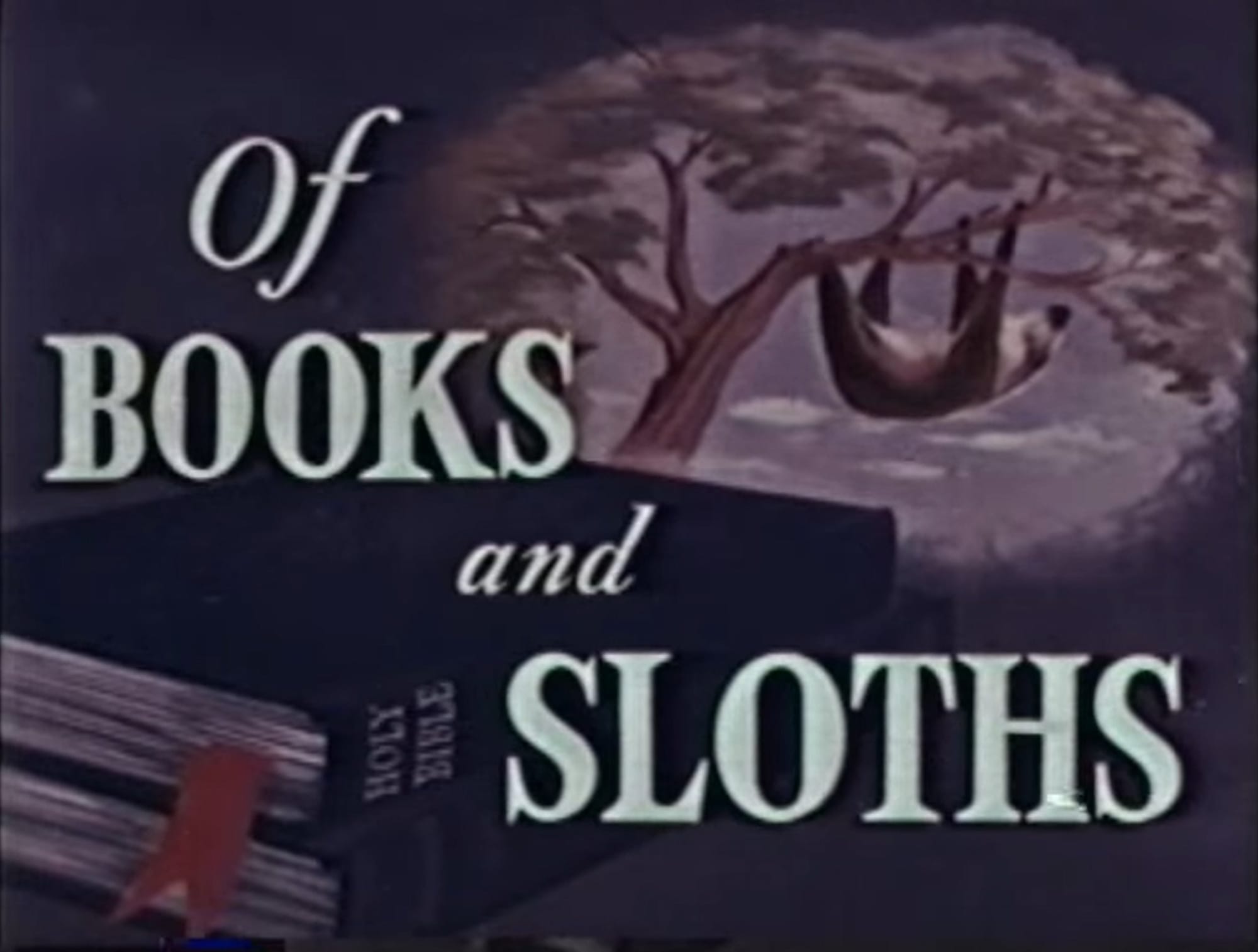
On Wednesday, June 19th, the Opera House hosted a performance from Spokane's own world-famous coloratura soprano, Patrice Munsel.(13)
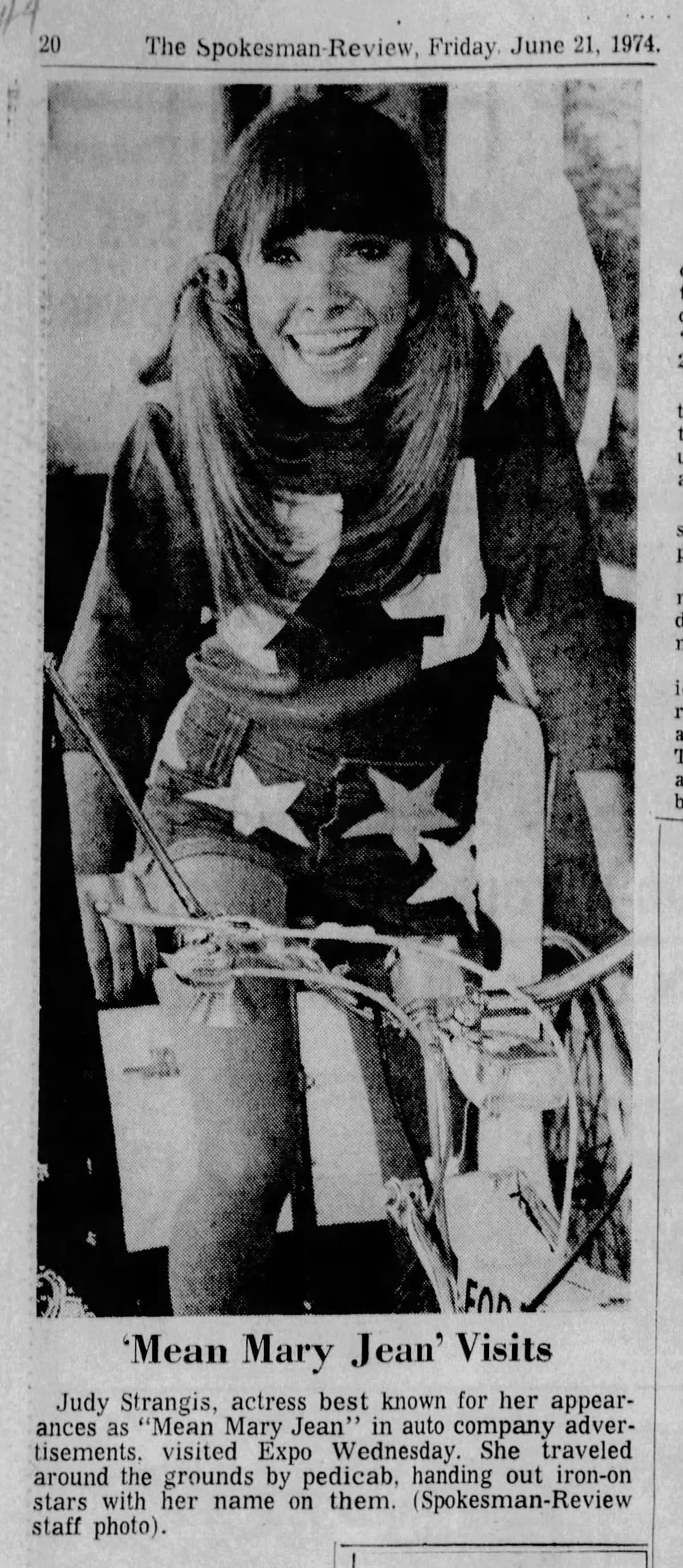
Thursday, June 20 was Ritzville Festival Day at the fair.(14) While Grand Funk Railroad was supposed to play at the Opera House on this night, their equipment bus broke down in Salt Lake City and their show was rescheduled to Monday.(15) The night of Friday, June 21 saw a performance in the Opera House from Rita Coolidge and Kris Kristofferson.(15)
ATTENDANCE
Through Friday night, total attendance at Expo '74 reached 1,463,465.(16)
PAVILION/EXHIBIT HIGHLIGHT: THE AFRO-AMERICAN PAVILION
“The Afro-American Pavilion symbolizes the heritage, pride and achievement of a great people living in a great land. It must be one of the highlights of your visit to Expo ’74. This is the first time in history that the contributions of the Black American have been presented at a world’s fair.”
- Expo ‘74 Official Guidebook
This is clearly the pavilion that belongs in the spotlight this week. For at least eight decades, nothing like this had been seen at world's fairs. Black advocates had asked again and again that African-American accomplishments be included in the U.S. Pavilions abroad or highlighted at World’s Fairs hosted on American soil. Their requests were always denied. This exclusion was particularly painful in light of the fact that Africa and Africans were often portrayed in past world’s fairs as uncivilized and primitive.
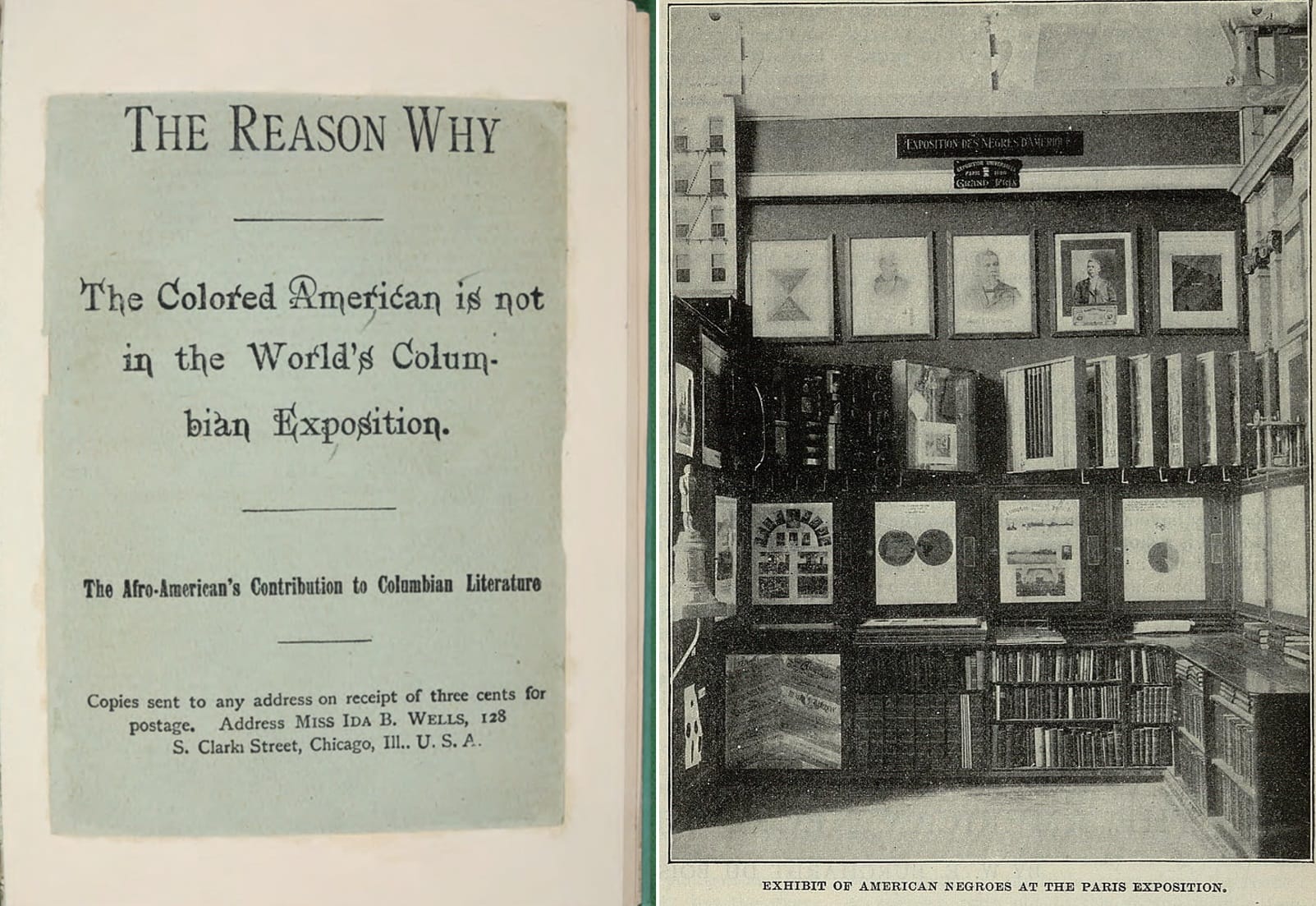
Expo '74 was the first World’s Fair to have an official pavilion celebrating the achievements of African Americans. The pavilion was developed by the non-profit Pan-African Foundation and sited opposite the U.S. Pavilion. Funds for the pavilion were raised from multiple public and private sources in a determined campaign.(17) Leaders of the fundraising effort included the pavilion's coordinator, Frank H. Russell, and Senator George Fleming of Seattle. Resources for the exhibit were loaned from museums, galleries, and archives all over the country.(18)
The Afro-American Pavilion (Official Guidebook, p. 75-77):
The Afro-American Pavilion is located on a 6,000 square foot landscaped site directly across from the United States Pavilion. It presents in pictorial, graphic, animated and dramatic form, the meaningful contributions that minority citizens of this nation have made to the orderly growth of our present environment. [...]
Upon entering the Pavilion foyer area, you’ll be confronted with a multi-hued montage of Black Heritage and origins displayed in a panoramic mosaic. Just overhead is a bold, three-dimensional representation of the Pan-African Foundation’s logo, a gigantic outline of the continent of Africa, with a cascade of rainbow-like streams crossing the top. The various arcs of the rainbow depict the variety of resources, both people and product-oriented, emanating from that continent.
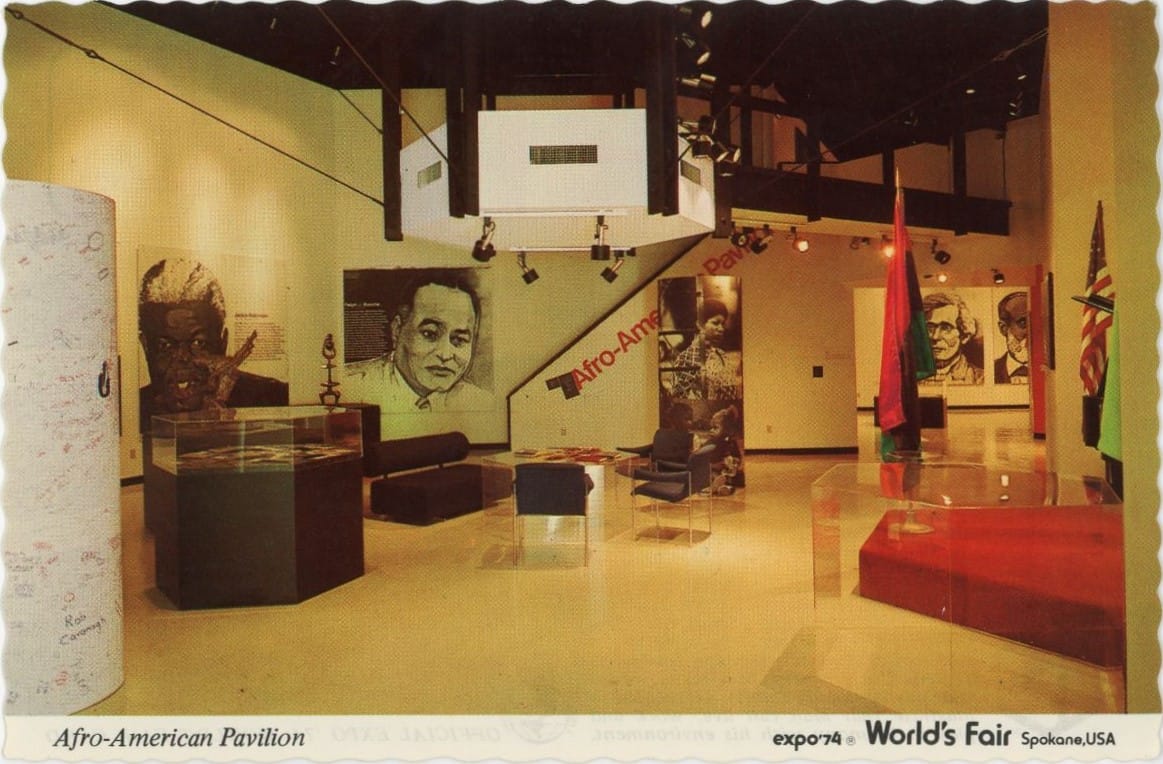
Moving in a semicircular path into the first display area, you’ll see a presentation of the history of Black people in this country, displayed in a multi-media technique which blends the contrasting images of a bank of slide projectors with motion picture scenes, all enhanced with a compelling musical and narrative sound accompaniment.
Another area of interest is the presentation of Black achievement in this country, a parade of living history illustrating the struggles and accomplishments of the Black man from the earliest days of the United States. The exhibits, live, animated or graphic, examine every major area of ethnic achievement, from letters to athletics, from business and religion to the visual arts.
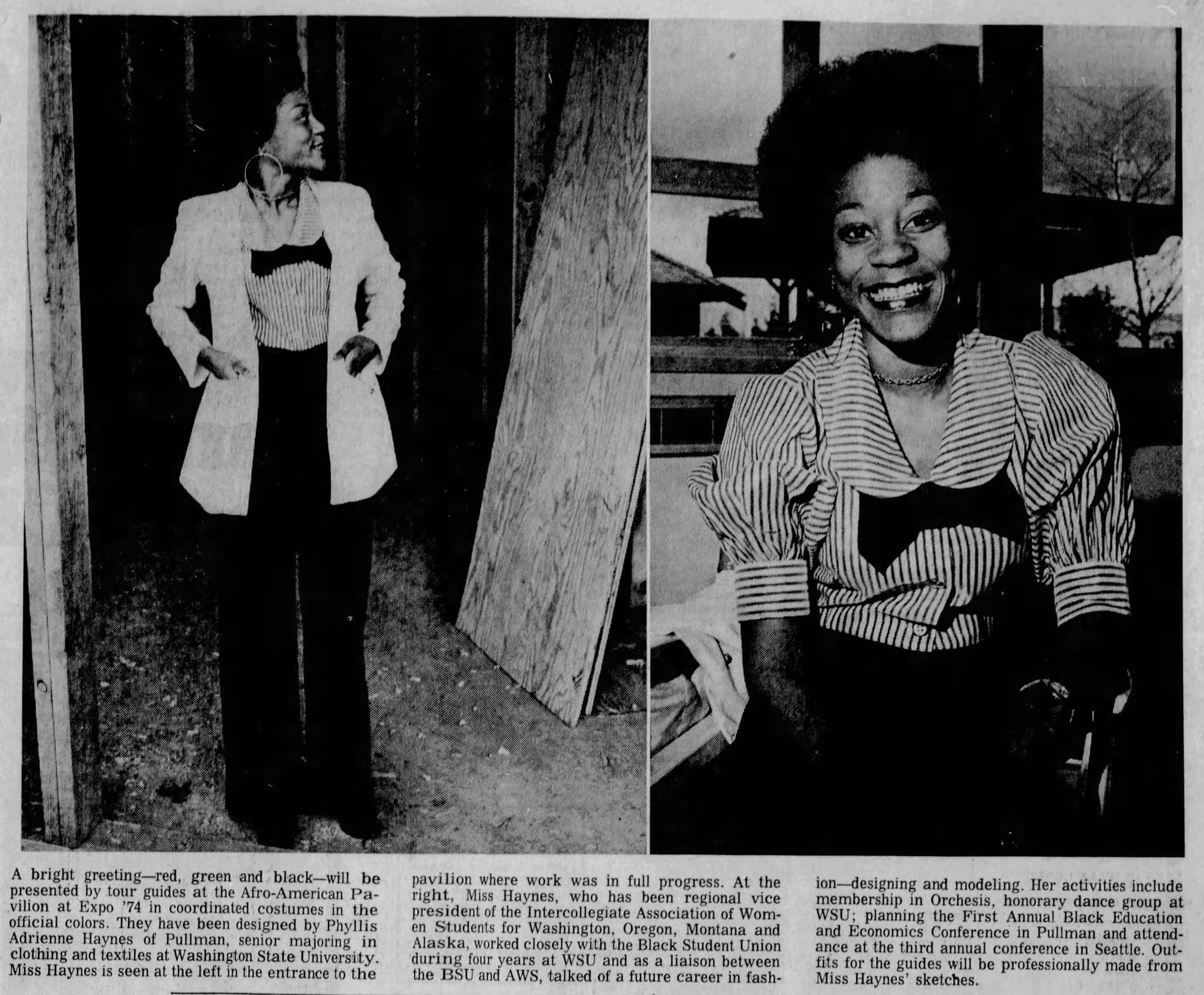
As you move into the next area, which is devoted to visible demonstrations and testimony of Black achievement, you come into a small staging area on which continuous entertainment and mini-shows are presented by Black artists and entertainers. This area is also used for a rotating display of contemporary Black painting, photography and sculpture, some of which has been commissioned just for the fair.
At various times, the rotating art exhibit at the Afro-American pavilion included works from Dorothy Yepez, Carlton G. Bell, Faith Ringgold, Hugh Harrell, Jacob Lawrence, Richmond Barthé, James Washington, Henry Ossawa Tanner, Archibald Motley Jr., LeRoy Clarke, Romare Bearden, and Raymond Saunders.(19, 20) WSU graduate Mikelle Egozi Fletcher was the art curator for the pavilion.
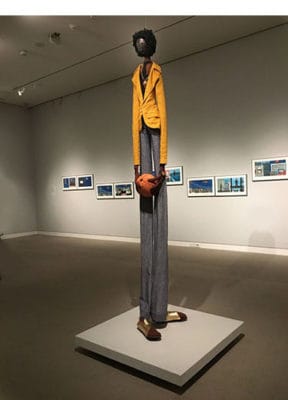
The Afro-American Pavilion spotlights and details primary contributions which the Black community have made to the American environment and to our enjoyment of it. The Pavilion underscores opportunities for a better life for Blacks in this country in terms of living standards, health and life expectancies.[...]
The Afro-American Pavilion symbolizes the heritage, pride and achievement of a great people living in a great land. It must be one of the highlights of your visit to Expo ’74. This is the first time in history that the contributions of the Black American have been presented at a world’s fair.
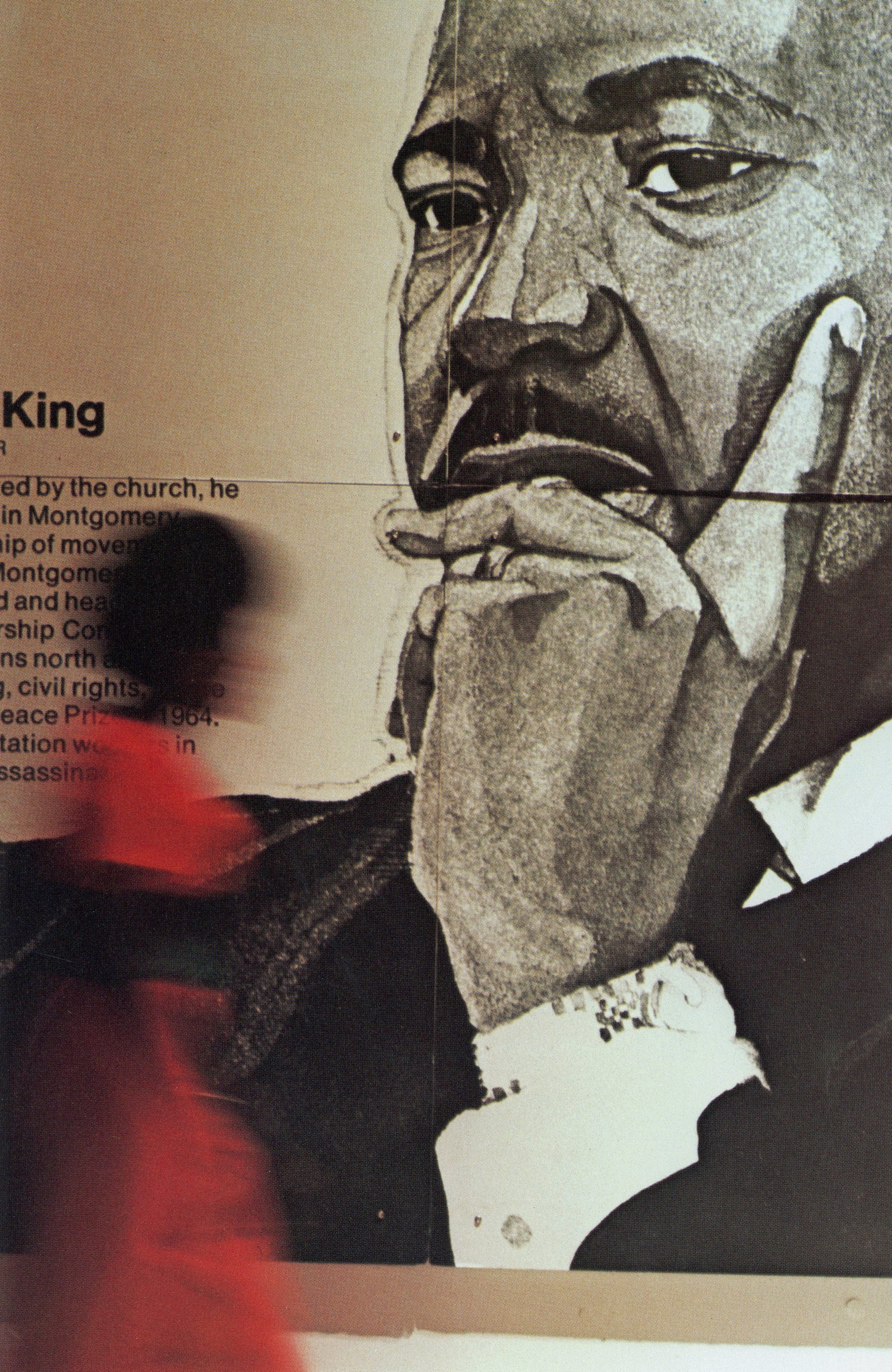
As far as I can tell, there was only an Afro-American Pavilion at one other fair, the Knoxville world's fair in 1982. After a certain point, I assume that it seemed more appropriate (and affordable) to simply include this perspective meaningfully in the U.S. exhibit, rather than coordinating a separate display. In the long run, that makes the most sense. But it somehow feels right that, when African American accomplishments first received their due at a world's fair, they were given their own dedicated space to shine. And it happened here in Spokane at Expo '74!
SOUVENIR OF THE WEEK

Until next time!
Past Topics:
REFERENCES AND FOOTNOTES
- "Culture of Blacks Stressed." (June 18, 1974). Spokesman-Review, p. 31. Via Newspapers.com: https://www.newspapers.com/article/the-spokesman-review-culture-of-blacks-s/149376088/
- "Dollmaker Popular At Folklife." (June 20, 1974). Spokesman-Review, p. 42. Via Newspapers.com: https://www.newspapers.com/article/the-spokesman-review-dollmaker-popular-a/149377349/
- "Blacks Celebrate Today." (June 19, 1974). Spokesman-Review, p. 11. Via Newspapers.com: https://www.newspapers.com/article/the-spokesman-review-blacks-celebrate-to/149485540/
- "Colville, Makah, Arapaho Indians Appear This Week." (June 18, 1974). Spokesman-Review, p. 30. Via Newspapers.com: https://www.newspapers.com/article/the-spokesman-review-colville-makah-ar/149376169/
- "Expo Indian Dancing Takes On Youthful Air." (June 20, 1974). Spokesman-Review, p. 8. Via Newspapers.com: https://www.newspapers.com/article/the-spokesman-review-expo-indian-dancing/149377129/.
- "Wheelchair Games Open." (June 15, 1974). Spokesman-Review, p. 13. Via Newspapers.com: https://www.newspapers.com/article/the-spokesman-review-wheelchair-games-op/149374325/
- "Expo Aids Paraplegics." (June 6, 1974). Spokane Chronicle, p. 26. Via Newspapers.com: https://www.newspapers.com/article/spokane-chronicle-expo-aids-paraplegic/148497994/
- "Miss Wheelchair America." (June 15, 1974). Spokesman-Review, p. 6. Via Newspapers.com: https://www.newspapers.com/article/the-spokesman-review-miss-wheelchair-ame/149374200/
- "Mrs. Dodd Lauded At Expo." (June 17, 1974). Spokesman-Review, p. 9. Via Newspapers.com: https://www.newspapers.com/article/the-spokesman-review-mrs-dodd-lauded-at/149375539/
- Barnes, Hazel. (June 17, 1974). "Bellringing Said Fascinating Art." Spokesman-Review, p. 3. Via Newspapers.com: https://www.newspapers.com/article/spokane-chronicle-bellringing-said-fasci/149375500/
- "Great Experience." (June 18, 1974). Spokesman-Review, p. 18. Via Newspapers.com: https://www.newspapers.com/article/the-spokesman-review-great-experience/149376521/
- "This Week At Expo '74." (June 17, 1974). Spokane Chronicle, p. 27. Via Newspapers.com: https://www.newspapers.com/article/spokane-chronicle-this-week-at-expo-74/149375006/
- "Expo Today: Fair's Timetable (June 19)." (June 19, 1974). Spokesman-Review, p. 1. Via Newspapers.com: https://www.newspapers.com/article/the-spokesman-review-expo-today-fairs/149376770
- "Ritzville, Wash., Saluted At Expo." (June 21, 1974). Spokesman-Review, p. 6. Via Newspapers.com: https://www.newspapers.com/article/the-spokesman-review-ritzville-wash-s/149377609/
- "Expo Today: Fair's Timetable (June 21)." (June 21, 1974). Spokesman-Review, p. 11. Via Newspapers.com: https://www.newspapers.com/article/the-spokesman-review-expo-today-fairs/149377473/
- "Expo '74: Fair's Timetable (June 23)." (June 23, 1974). Spokesman-Review, p. 1. Via Newspapers.com: https://www.newspapers.com/article/the-spokesman-review-expo-today-fairs/149487461/
- Powers, Dorothy. (March 13, 1974). "Afro Pavilion's Fund Goal Met." Spokesman Review, p. 1. Via Newspapers.com: https://www.newspapers.com/article/the-spokesman-review-afro-pavilions-fun/149483453/
- "Afro-American Exhibit Presents Diverse Talents." (May 5, 1974). Spokesman-Review, p. c21. Via Newspapers.com: https://www.newspapers.com/article/the-spokesman-review-afro-american-exhib/149483709/
- "Noted Artist Has Works At Expo '74." (June 30, 1974). Spokesman-Review, p. 8. Via Newspapers.com: https://www.newspapers.com/article/the-spokesman-review-noted-artist-has-wo/149437714/
- Hull, Roger. (July 17, 1974). "Black Art Is Vital, Varied." Spokane Chronicle, p. 33. Via Newspapers.com: https://www.newspapers.com/article/spokane-chronicle-black-art-is-vital-va/149482836/
- Gilbert, Cynthia. (June 10, 1974). "Expo Display Counters History." Spokane Chronicle, p. 34. Via Newspapers.com: https://www.newspapers.com/article/spokane-chronicle-expo-display-counters/148937196
